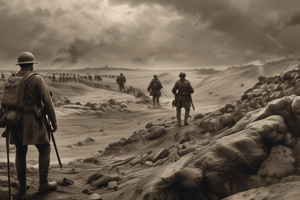Podcast
Questions and Answers
What characterizes ocean trenches geologically?
What characterizes ocean trenches geologically?
- Their wide width
- Their extreme depth (correct)
- Their proximity to the surface
- Their high temperature
Why is life in ocean trenches highly challenging?
Why is life in ocean trenches highly challenging?
- High pressure and low temperatures (correct)
- Low pressure and high temperatures
- Low pressure and low temperatures
- High pressure and high temperatures
How do organisms in ocean trenches adapt to the harsh conditions?
How do organisms in ocean trenches adapt to the harsh conditions?
- By decreasing body size
- By increasing surface area
- With gelatinous bodies that resist compression (correct)
- By increasing body temperature
What causes the formation of ocean trenches?
What causes the formation of ocean trenches?
What makes ocean trenches the deepest points on Earth?
What makes ocean trenches the deepest points on Earth?
Why is life in ocean trenches considered thriving despite the difficult conditions?
Why is life in ocean trenches considered thriving despite the difficult conditions?
What is the primary purpose of trenches in the context of warfare?
What is the primary purpose of trenches in the context of warfare?
How did trench systems evolve from simple foxholes during wartime?
How did trench systems evolve from simple foxholes during wartime?
What was the purpose of communication trenches in the trench system?
What was the purpose of communication trenches in the trench system?
Why were trenches dug in a zigzag pattern during warfare?
Why were trenches dug in a zigzag pattern during warfare?
What distinguished different lines of trenches in a typical trench system?
What distinguished different lines of trenches in a typical trench system?
What major historical event during the 20th century highlighted the significance of trench warfare?
What major historical event during the 20th century highlighted the significance of trench warfare?
Study Notes
Trenches: An Overview
The term "trenches" refers to two distinct concepts: military fortifications and geological formations. In the context of warfare, trenches are dug into the ground to provide temporary or semi-permanent protection for soldiers. During World War I, trenches were a significant component of trench warfare, with armies constructing complex networks of interconnected trenches to counteract the technological advantage of the opposing force. On the other hand, ocean trenches represent the deepest points in the ocean, where sections of the earth's crust descend below the surface to meet another tectonic plate.
Military Trenches
In the realm of warfare, trenches served as a protective barrier for soldiers, enabling them to launch attacks without exposing themselves directly to enemy fire. Early trench systems began as simple collections of foxholes, which were later expanded into more extensive networks of trenches and bunkers. During World War I, trench warfare saw the use of multiple lines of trenches, including an outpost line, main line of resistance, and support line, each serving specific defensive purposes.
The typical trench system was designed to minimize vulnerability to enemy fire. Trenches were dug in a zigzag pattern to limit the effectiveness of long-range weapons, and each line of trenches was connected by communication trenches for the delivery of supplies and orders. Additionally, several layers of trenches were built to accommodate different types of defenses, ranging from machine gun emplacements to underground shelters for large numbers of troops.
Ocean Trenches
Geologically speaking, ocean trenches refer to long, narrow depressions on the seafloor that mark the deepest points on Earth. These features occur where one tectonic plate is forced beneath another, leading to the formation of new crust as the plates collide. Ocean trenches are characterized by their extreme depth, with some reaching over 6000 meters below the surface.
Life in ocean trenches is highly challenging due to the high pressure and low temperatures, which often exceed those found at the Earth's surface. Organisms living in these environments exhibit unique adaptations, such as gelatinous bodies that resist compression or specialized feeding behaviors adapted for the harsh conditions. Despite the difficult living conditions, life within these deep-sea habitats has evolved to thrive in one of nature's most extreme environments.
Studying That Suits You
Use AI to generate personalized quizzes and flashcards to suit your learning preferences.
Description
Explore the dual concepts of trenches, from military fortifications used in warfare to geological formations found in oceanic depths. Learn about the historical significance of trenches in warfare, including their construction, defensive strategies, and impact on combat tactics. Delve into the geological phenomenon of ocean trenches, examining the formation process, extreme depths, and unique adaptations of organisms in these challenging environments.




